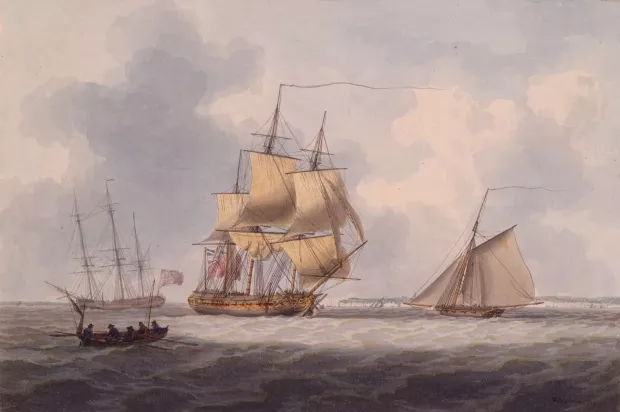Creation Date
1797
Height
20 cm
Width
30 cm
Medium
Genre
Description
William Anderson's Frigate is an example of many marine images which portrayed British ships simply existing on the sea. The British flags prominently displayed on both frigates ensure that the observer realizes the connection between this scene and the British nation. This image portrays three ships and a row boat, presumably transporting the pilot to the central frigate. The ocean is rough with small waves, and the sails of the ships billow with wind. Both the foremost frigate and the frigate further back and to the left display British flags which blow to the right. In the distance, a coastline extends along the left and right portions of the horizon. White cliffs mark the edge of the coast to the right, while the coast to the left is lower, marked only by greenery and possibly a thin beach at the water’s edge. Distant ships appear in the background between the coasts, suggesting the existence of a port. The frigate on the left has all of its sails raised. It is leaning to the left, away from the viewer, while the central frigate has all but one of its sails lowered completely and is leaning to the right, away from the viewer. Unseen clouds cast dark shadows over the row boat in the bottom left of the painting, which appears to be pulling towards the central frigate. These shadows also partially obscure the second, more distant frigate, while the central frigate is illuminated in a patch of light. The smaller, more distant ship to the right is also slightly shadowed.
This watercolor is an example of many marine images which portrayed British ships simply existing on the sea. The British flags prominently displayed on both frigates ensure that the observer realizes the connection between this scene and the power of the British nation. When contrasted with the glassy, calm water depicted in Anderson’s Shipping Off the Dutch Coast, the choppy sea in A Frigate Awaiting a Pilot becomes more notable. This image of ships swayed by the waves and wind—visible in the straining sails and ruffled waters— impresses upon the viewer the majestic balance of resistance and flexibility enabling the ships to coexist with the elements on this volatile surface. Anderson makes emphatic use of light and shadow both to imply the presence of the wind pushing unseen clouds above and to draw attention to the illuminated, central frigate. This play between light and dark further suggests the unpredictable nature of the sea, its varied surface now rough with wind. The mystery created by Anderson's representation of the sea makes the British claim to this space, emphasized by the powerful form of the central frigate, even more daring and impressive. Finally, the flags prominently displayed on the frigates enhance the sense of national pride evoked by the ships which—within sight of the distant British port and coast—hold their position on the sea against the natural, invisible forces attempting to govern them. Consequently, the power of the British Isles is extended beyond land by the powerful, versatile movement of the frigates.
Associated Works
Copyright
Copyright, 2009, Yale Center for British Art, Paul Mellon Collection
Collection
Accession Number
B1975.3.1090
Additional Information
Bibliography
Bénézit, E., et al. "William Anderson." Benezit Dictionary of Artists. Vol 9. Paris: Gründ, 2006. Print.
Brook-Hart, Denys. British 19th Century Marine Painting. Suffolk: Baron Publishing, 1974. Print.
Cordingly, David. "Nicholas Pocock (1740-1821)." Oxford Dictionary of National Biography. Ed. H. C. G. Matthew and Brian Harrison. Oxford: Oxford UP, 2004. Web. 7 April 2009.
Dayes, Edward. The Works of the Late Edward Dayes. London, 1805. Print.
Tracy, Nicholas. Britannia's Palette: The Arts of Naval Victory. Montreal: McGill-Queen's UP, 2007. Print.

